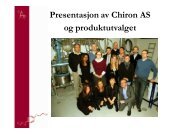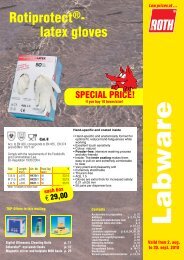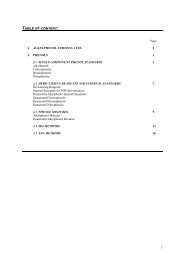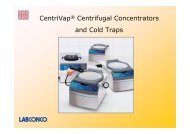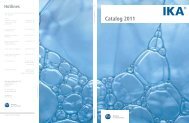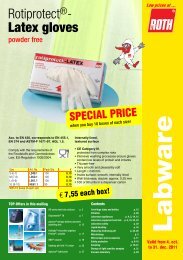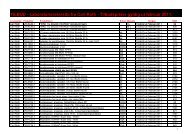Catalog 2010 Technology for Vacuum Systems - Chiron
Catalog 2010 Technology for Vacuum Systems - Chiron
Catalog 2010 Technology for Vacuum Systems - Chiron
Create successful ePaper yourself
Turn your PDF publications into a flip-book with our unique Google optimized e-Paper software.
Choosing vacuum equipment<br />
For vacuum concentrators<br />
■ <strong>Vacuum</strong> concentration makes many demands on the supporting vacuum system, both in terms of the ultimate vacuum<br />
and in the selection of accessories. The pump needs high resistance to chemicals, as well as good tolerance of condensates.<br />
Type of solvents in use and the nature of the samples both have a strong influence on the ultimate vacuum<br />
needed and the appropriate type of process controls. Determining the optimum heat transfer into the sample material<br />
is also vital to avoid the need to upgrade your pump later.<br />
Process requirements<br />
■<br />
■<br />
optimum heat transmission to the sample vessels<br />
medium to high vacuum requirements<br />
■ fast and highly sensitive vacuum regulation with samples that<br />
tend to foam<br />
■ condensate and droplet precipitation between the pump and concentrator<br />
Demands made of the vacuum pump<br />
■<br />
■<br />
■<br />
■<br />
great resistance to chemicals<br />
ultimate vacuum as much as 7 mbar or 1.5 mbar<br />
sufficient volume flow rate (2 m³/h and more)<br />
not sensitive to condensate<br />
■ inclusion of a vacuum inlet separator (AK) made of glass to protect<br />
the pump from particles and droplets of liquid<br />
emission condenser <strong>for</strong> solvent recovery and to minimize environ-<br />
■ mental and laboratory air pollution<br />
Recommended systems<br />
An ultimate vacuum of as much as 7 mbar is sufficient <strong>for</strong> organic solvents and/or small amounts of H 2 O<br />
An ultimate vacuum of as much as 1.5 mbar is advisable <strong>for</strong> aqueous samples, high boiling point solvents<br />
and/or low working temperatures.<br />
This especially concerns solvents such as DMF, DMSO, NMP or DMAC.<br />
VARIO ® pumping units with automatic vacuum optimization are the best option <strong>for</strong> gentle concentration<br />
operations and <strong>for</strong> mixtures of substances that tend to boiling delay.<br />
Final pressures of as low as 10 -3 mbar may be necessary <strong>for</strong> optimum residual drying or <strong>for</strong> high-temperature<br />
boilers at very low evaporation temperature. The chemistry-HYBRID TM pump RC 6 has proved its worth here.<br />
A cold trap can be located upstream of any of the pumps to boost flow-through, if helpful.<br />
Choosing vacuum equipment<br />
pg. 34<br />
pg. 46<br />
pg. 44, 50<br />
pg. 122<br />
Further in<strong>for</strong>mation at www.vacuubrand.com<br />
17



